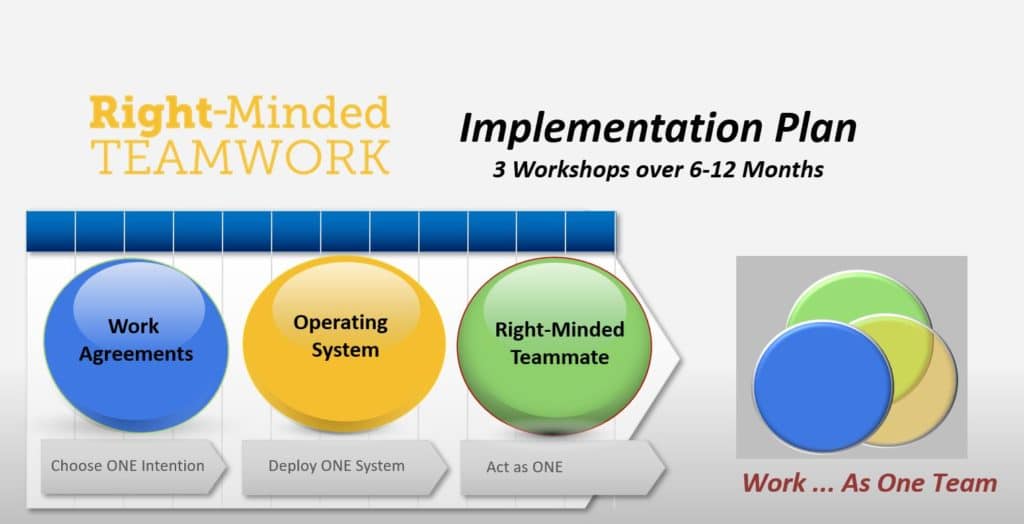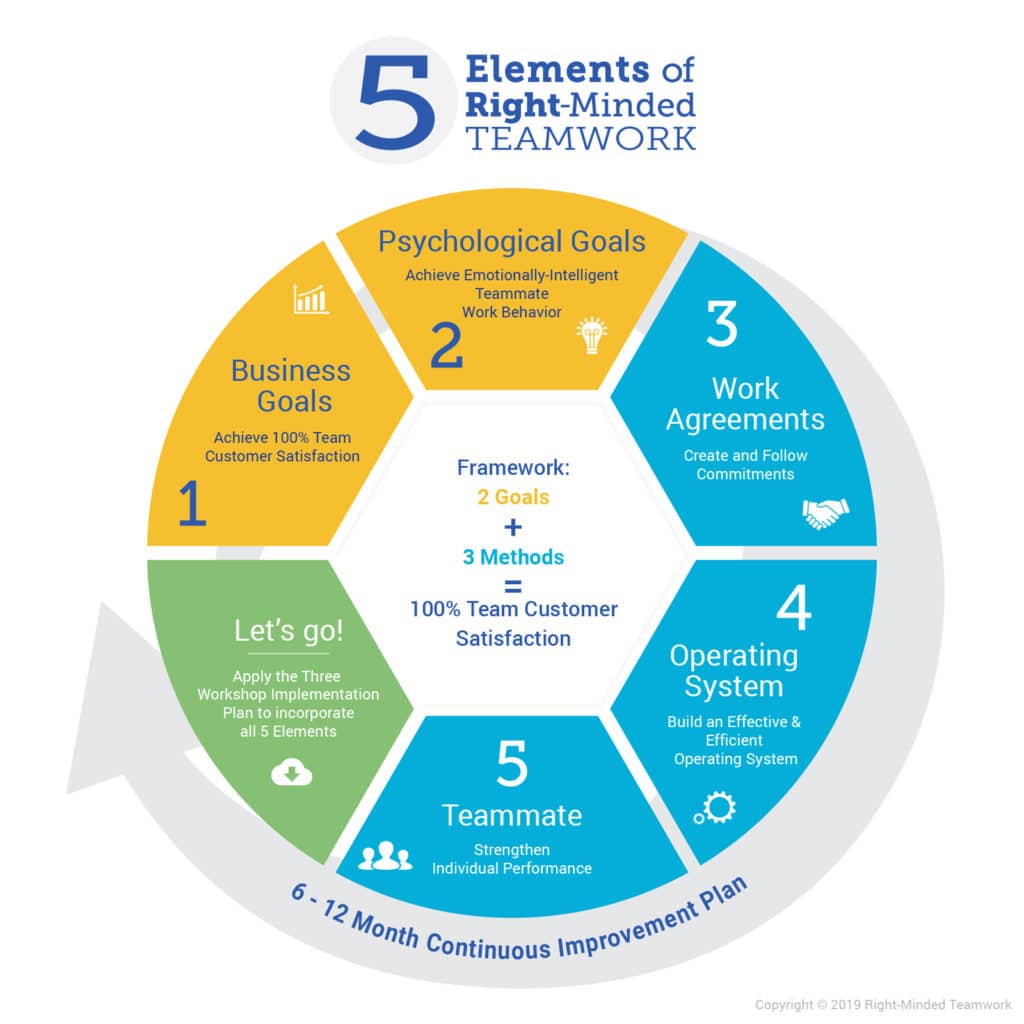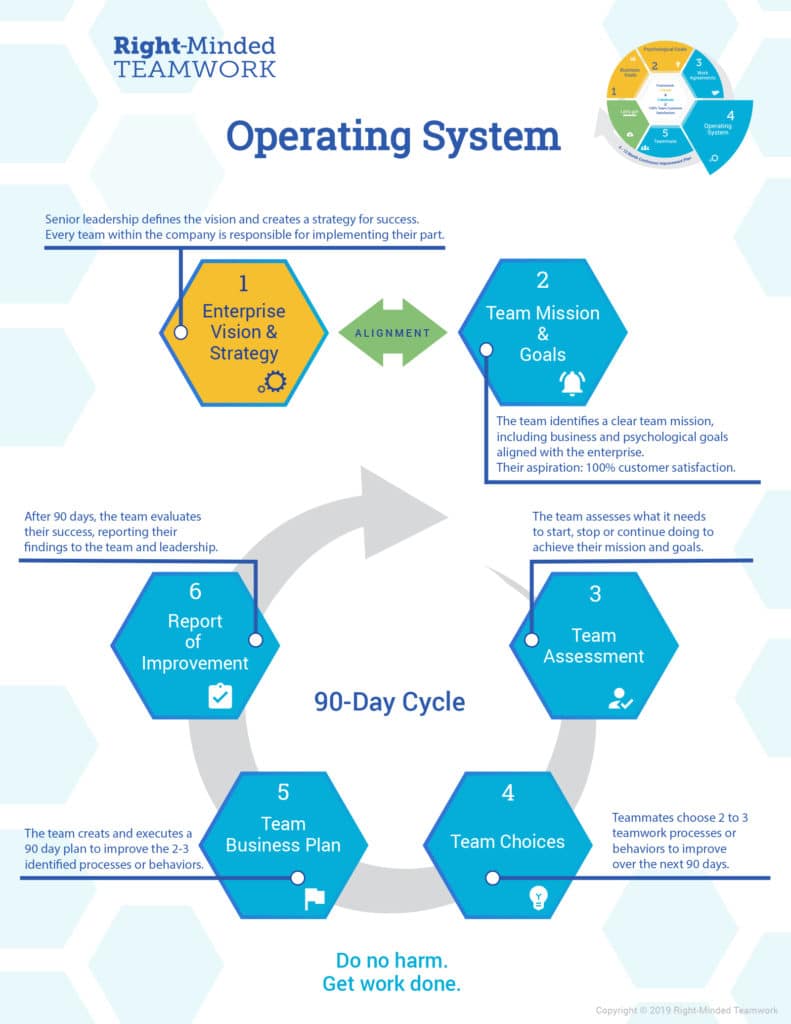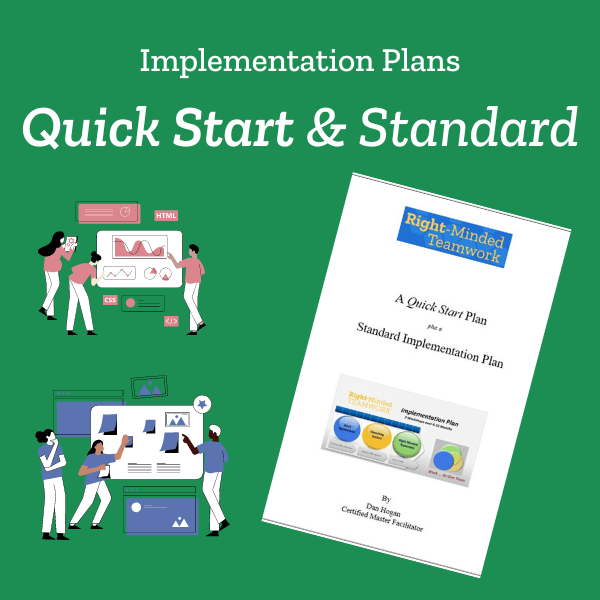What Do Leaders Do … to achieve effective teamwork?
There are two simple and undeniable answers.
1. Leaders and teammates live and demonstrate the Right-Minded Teamwork Motto
Do No Harm & Work as One.
2. Leaders apply a real-world, continuous-improvement, team-building method [no silly team games, please!] like Right-Minded Teamwork’s 5 Elements [RMT].
In this article, you will learn about RMT 5 Element framework and how to apply them in your team with our Quick Start or Standard plans.
Table of Contents
RMT’s 5-Element Framework: 2 Goals & 3 Methods
RMT’s Implementation Plans: a Quick Start & Standard Plan

Right-Minded Teamwork’s 5-Element Framework
“Right-Minded Teamwork separates the games of “team bonding” from the hard work of team building. [It is] real-world team building in a realistic, direct, and safe manner. Right-Minded Teamwork is also a support system, providing a rich array of resources.”
Patrick Carmichael, VP Best Practices Institute, Former Head Talent Management at Saudi Aramco.
There are 2 Team Goals
The first two are specific goals that provide direction and a way to measure progress and success. There are two:
1. Business Goals
2. Psychological Goals
In order for a team to succeed, each team member must first know, understand, and choose to align with the team’s overarching performance business goals. All team members must also know, understand, and choose to align with the team’s psychological goals that relate to interpersonal, behavioral, and communication goals.
By clarifying and communicating both business and psychological goals, all teammates are offered a level playing field. Recognizing the value of each team member to the whole allows each individual member to contribute fully and willingly, no matter their role.
There are 3 Methods for Achieving Team Goals
3. Team Work Agreements ensure teammate work behavior is aligned towards achieving team goals.
4. Team Operating System ensures effective teamwork methods which achieve team goals.
5. Right-Minded Teammate development naturally encourages personal teammate growth.
Let’s take a brief look at each of these methods.
Team Work AgreementsA Work Agreement is a collective teammate promise to transform non-productive, adversarial behavior into collaborative teamwork behavior. More are short promises, written collectively by the team, that describe how team members agree to Do No Harm and Work together as One. They guide the team by providing a set of clear expectations around teammate attitude and work behavior.
The Team Operating SystemRMT’s Team Operating System is a six-step, 90-day, continuous improvement system that organizes team functions to increase the likelihood of achieving customer satisfaction. More organizes a team’s processes and work procedures. It defines roles, responsibilities, and how the team will reach its goals. You can use RMT’s 6-Step Model which includes a Team Performance Factor Assessment.
Right-Minded Teammates view their team’s success collectively. Everyone supports everyone else by doing their best, knowing group success requires a high level of individual performance from everyone involved. Thus, every teammate is committed to personal growth and development.
When teams unify around their business and psychological goals and apply these three methods to create effective teamwork, RMT’s 5-Element model can turn any team around.
True RMT Success Story
When team leaders apply real-world team building, continuous improvement is the natural result.
Facing a potential shutdown from their credentialing agency after a significant performance decline, Joel Sorensen, Vice President of the Prairie Island Nuclear Power Plant in Minnesota, knew things needed to change. So he implemented Right-Minded Teamwork (specifically, the 3rd Element, Work Agreements) to support teammate behavioral alignment with the company’s vision, mission, and values.
Shortly after establishing team Work Agreements, team members began to respectfully hold each other accountable, ensuring everyone was honoring their commitments. Individual team members began going above and beyond simply because they could and wanted to. Any conflicts that arose were addressed in a professional and supportive way.

“If you had asked me 2 months ago if the leadership team would reach this level of performance, my answer would have been emphatically, “NO!”
Now that we are on this road, I don’t ever want to go back.” ~ Joel Sorensen, Former Vice President, Prairie Island Nuclear Power Plant
RMT’s Implementation Plans: a Quick Start & Standard Plan
A Quick Start Implementation Plan
Start your Right-Minded Teamwork journey without having to study all 8 RMT books.
Conduct your 1st team-building workshop. At its end, agree on “what” your team will address in your 2nd workshop plus set the date.
Hi Dan. Just conducted your Work Agreement workshop. Went great, and passed the info along to other coaches I know. … they [now have] a wonderful common language and could follow your decision-making model to determine how best to handle similar situations in the future. Thanks for the material! Vickie – Team Coach
Quick Start Steps
1. Identify a teamwork issue that needs addressing, improving, or correcting.
2. In the 1st workshop, all teammates …
- Discuss and define the issue and when everyone agrees on what the problem actually is,
- Teammates discuss and agree on solutions that result in team Work Agreements
3. All teammates actively live their team Work Agreements by
- Tracking progress
- Make needed adjustments along the way and then
- Measure the team’s improvement results
4. Repeat steps 1-3
- Conduct your 2nd workshop
- Facilitate a team-building workshop every 2-3 months
Results
Your team will experience a boost in productivity and motivation from the first workshop alone which builds positive expectations for the second Right-Minded Teamwork workshop.
Standard Implementation Plan
Orientation + Three Workshops + 90-Day Operating System

Standard Implementation Steps
There is no one right way to implement RMT. However, this plan has proven effective countless times. Combining orientation, three team-building workshops, and a 90-day Team Operating System will ensure you succeed in creating a team that works together as one.
Here is a high-level view of the five steps or phases of RMT’s 5 Elements Implementation Plan:
- Team Orientation Meeting & Workshop Preparation
- The team leader & facilitator prepare for team orientation
- Conduct a short orientation meeting and assign teammate preparation tasks
- Identify team psychological goalsA team’s psychological goals describe how teammates intentionally choose to think and behave as they work together to achieve their team’s business goals. More and values (Element #2)
- Create at least one team Work Agreement (Element #3)
- Identify one to two improvement projects for the next 90 days
- Second Workshop – Operating System
- Reset and reaffirm business goals (Element #1) and agree on the Team Operating System (Element #4) by conducting a Team Performance Factor Assessment.
- Third Workshop – Teammates
- Conduct a Right-Minded Teammate development workshop (Element #5)
- 90-Day Operating Plan – Ongoing
- Every 90 days, conduct another Team Performance Factor Assessment. The team meets to assess progress, identify opportunities, then act to achieve new teamwork improvements.
Your Next Steps
Everything you want to know about the RMT 5-Element Framework and the Implementation Plans is in this book, Right-Minded Teamwork in Any Team: The Ultimate Team Building Method to Create a Team That Works as One.
In that book, you will also find four real-world success stories that will help guide you in adapting and adopting Right-Minded Teamwork in your team.
And PLEASE, contact me if may support you in your Right-Minded Teamwork journey. I used these methods for 40 years. They work and I would love to see them work for you and the teammates and customers you serve.
May the Oneness be with you.

Dan Hogan, Certified Master Facilitator




